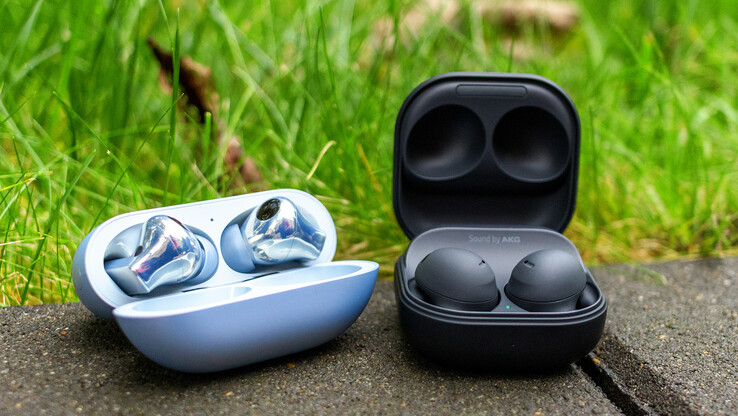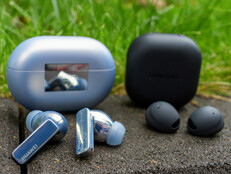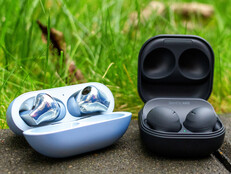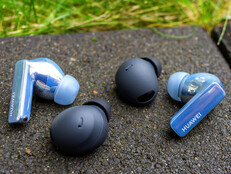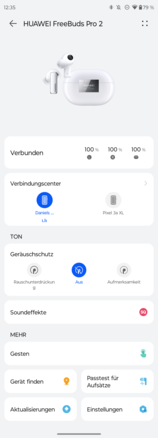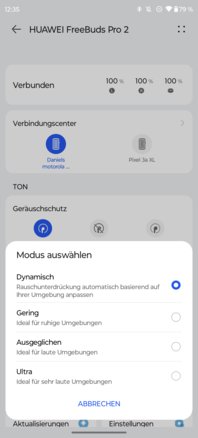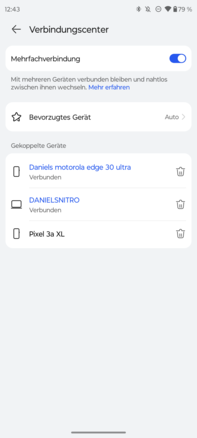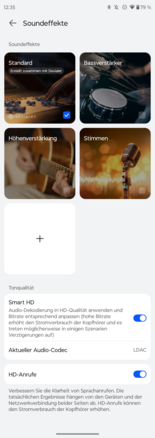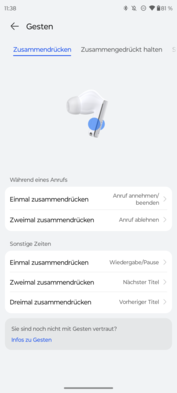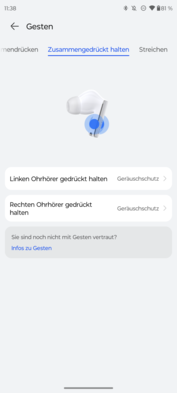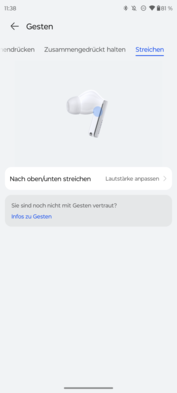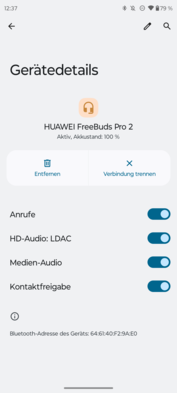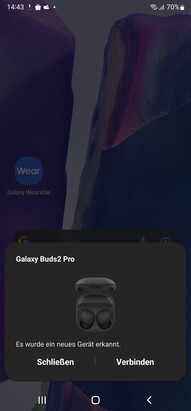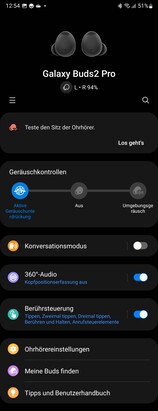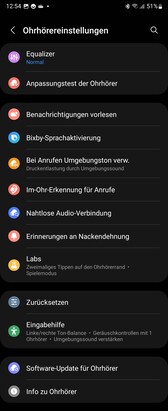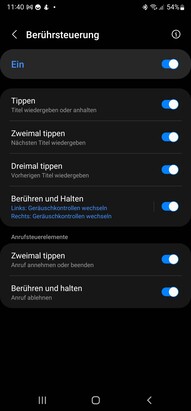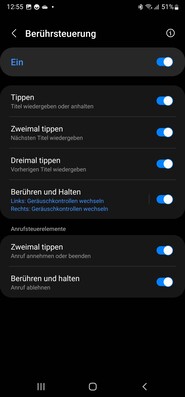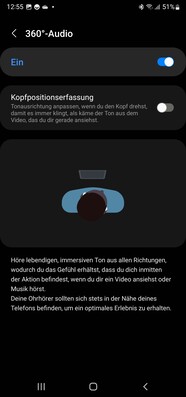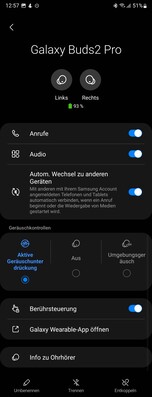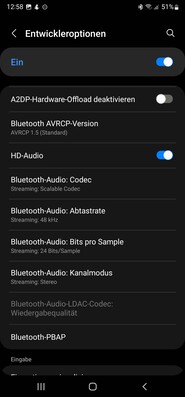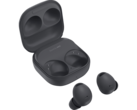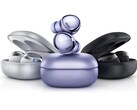Comparison review: Samsung Galaxy Buds2 Pro vs. Huawei FreeBuds Pro 2
Samsung's Galaxy Bus2 Pro has become even more compact than its predecessor. The audio performance is tuned by AKG and supports 24-bit sound for the first time. The Huawei FreeBuds Pro 2 rely on the support of Devialet's audio specialists, and Sony's LDAC codec is used for a wide transmission bandwidth.
That reads like different ways to get there, but the two competitors differ even more. This is not only true for the design, but especially for the telephony features, battery runtimes and compatibility.
Specifications
| Huawei FreeBuds Pro 2 | Samsung Galaxy Buds2 Pro | |
|---|---|---|
| Wearing style | in-ear | in-ear |
| Connectivity | Bluetooth 5.2 | Bluetooth 5.3 |
| Speakers | Dual-Speaker | 2-way (tweeter and woofer) |
| Microphones | 3 | 3 |
| Audio codecs | SBC, AAC, LDAC | SBC, AAC, Samsung Seamless Codec HiFi |
| Battery power (earphones) | 55 mAh | 58 mAh |
| Battery power (charging case) | 580 mAh | 500 mAh |
| Charging port | USB-C | USB-C |
| wireless charging | yes | yes |
| Certifications | IP54 | IPX7 |
| Weight (per earphone) | 5.9 g | 5.5 g |
| Weight (empty charging case) | 52.1 g | 43.4 g |
| Firmware version | HarmonyOS 3.0.0.178 | R510XXU0AV17 |
| Scope of delivery | FreeBuds Pro2, USB cable (Type-A to Type-C), silicone ear pads (S, M, L), quick start guide, warranty conditions | Galaxy Buds2 Pro, USB-C cable, silicone ear pads (S, M, L), quick start guide, warranty conditions |
| Price (MSRP) | 199 Euros | 229 Euros |
Case and ergonomics - Galaxy Buds2 Pro with tighter fit and IPX7
Both True Wireless Headphones (TWS) are made of plastic, but they look very different from each other. While Huawei based the design on the Apple AirPods Pro, the Galaxy Buds2 Pro are much more compact and do without a microphone boom. The build quality is impeccable in both in-ear headphones. The FreeBuds Pro 2 are available in white, silver and the iridescent Silver Blue, while the Samsung TWS are offered in Bora-purple, white and graphite. The latter are our test devices in each case.
Both headphones come with three different sized in-ear attachments: S, M and L, with the middle size already attached on both. However, the Buds2 sit tighter and deeper in the ear canal, while the Huawei earphones exert less pressure. Samsung might therefore be the better choice for athletes, but the FreeBuds also hold securely in our ears in the test. Both TWS headphones also have an IP certification. Huawei offers IP54, which means protection against dust in harmful amounts as well as against splashing water on all sides. The Galaxy Buds2 Pro do not have IPX7 protection against foreign bodies, but they are protected against temporary submersion. However, neither model should be exposed to a shower or even a swimming pool.
Features and operation - FreeBuds Pro 2 with broader compatibility
The Huawei FreeBuds Pro 2 can simply be put into pairing mode via a button on the charging case; Google Fast Pair is not supported. The situation is different for Samsung's headphones. If a Android smartphone or tablet is nearby during the first use, the Buds2 Pro are recognized directly and can be paired. However, both headphones support Microsoft's Swift Pair.
Apps for Android and iOS or iPadOS are available for both models. Huawei's own AI Life app is also available in the AppGallery. However, it cannot be downloaded directly from the Play Store in a Google system, but is easiest to install by scanning the QR code on the packaging. It is best to install the respective apps first, which then guide the user through the setup process in simple steps.
Huawei FreeBuds Pro 2
Once the setup is done, playback can start directly. However, there is a lot to discover in the app's settings. It starts with noise protection, which can be used to turn active noise cancellation and Transparent Hearing (attention) on or off. A dynamic mode is used for ANC, which automatically adjusts the intensity to the environment. Alternatively, one of the three fixed modes can be selected.
It is easy to switch between several paired devices in the connection center. However, this was rarely the case in our test due to the dual-Bluetooth support. Furthermore, the press and swipe gestures can be configured comprehensively there. These can be used to control media content, phone calls, noise protection, activate the voice assistant or adjust the volume. This is quite complex at first, but it can be practiced via a tutorial and leaves practically nothing to be desired.
If you want to use features like HD telephony or the powerful LDAC codec, you first have to activate them in the sub-item Sound Effects, where you can also use predefined equalizers or define your own.
Samsung Galaxy Buds2 Pro
Many settings can also be adjusted for the Samsung headphones via the app, but many options are already available in the system dialog at Android. Unlike the FreeBuds Pro 2, the Galaxy Buds2 Pro do not support full-fledged dual Bluetooth. However, the connection can be handed over to other Samsung devices without new pairing processes.
Controls are via touch on the headphones and can be customized by the user. Besides media control, rudimentary phone operation is possible. Furthermore, noise control or Bixby can be controlled. It is a pity that Samsung leaves other voice assistants out at this point.
However, we like the conversation mode. If it is activated, the media volume is automatically reduced and the device switches to transparency mode when a voice is recognized. If the conversation partners remain silent for at least ten seconds, this is automatically ended.
Sound - Two strong ANC headphones with decent to good sound
The two TWS headphones both rely on a two-way speaker solution and 24-bit sampling despite the limited space. This promises a comparatively high playback quality. Samsung speaks of real hi-fi sound as well as 360-degree audio, and Huawei of Hi-Res HD audio.
Huawei relies on Sony's LDAC codec (24-bit, up to 96 kHz), which has a high transmission bandwidth of 990 kbps and is supported by all reasonably up-to-date Android smartphones and tablets, to transfer the audio signals from the source to the earphones in a corresponding quality. Apple-Users will have to make do with the weaker AAC codec (up to 320 kbps). Samsung uses a proprietary codec, the Samsung Seamless Codec HiFi (SSC). Samsung doesn't reveal much more details about it. The disadvantage is that it only works with Galaxy smartphones and tablets that have One UI 4.0 or later installed. All other devices have to make do with AAC.
Both headphones show a coherent reproduction in audio playback, in which the high tones are largely dominant. This is especially pleasant when watching movies, since voices come to the fore better, whereas music seems a bit flat. The latter is especially true for the Galaxy Buds2 Pro, which already lacks power and precision in the mids. The FreeBuds Pro 2 manages to make these much more present and crisp. The Huawei TWS also has a better signal fidelity in the measurements.
The situation is similar in telephony. The Huawei headset also has an advantage here. It shines with a great speech quality in quiet environments when the HD option is enabled, but it is still good without it. The FreeBuds also benefit from noise-canceling during calls, which reliably filters out minor noise. However, noisy offices or main streets are too much even for the Huawei TWS. The Galaxy Buds2 Pro are also still good in a quiet environment, but the user will always sound a bit muffled. If noise is added, voice transmission can be interrupted.
In terms of active noise cancellation, both headphones perform well. Although they cannot compete with the big over-ear headphones, they audibly reduce ambient noise. Fans, humming devices, and even outside street traffic can be reduced well with these. Dynamic adjustment should be selected for the FreeBuds Pro 2, as the maximum level may not always be the best. Indoors, for example, noise can often be heard in Ultra mode.
Transparent Hearing also works reliably, but is accompanied by audible noise, especially in Huawei's case.
| Loudspeakers | |
| THD | |
| Samsung Galaxy Buds2 Pro (RMS: -3.0 dBFS) | |
| Huawei FreeBuds Pro 2 (RMS: -3.0 dBFS) | |
| THD+N | |
| Samsung Galaxy Buds2 Pro (RMS: -3.0 dBFS) | |
| Huawei FreeBuds Pro 2 (RMS: -3.0 dBFS) | |
* ... smaller is better
THD (Total Harmonic Distortion): Harmonic distortion quantifies the magnitude of the components that arise due to non-linear distortion (harmonic content) in relation to the original signal. THD only refers to the fundamental component. The distortion factor is often mentioned in the same breath, but refers to the total signal.
THD+N (Total Harmonic Distortion + Noise): This value is comparable to THD, but in addition to the harmonic distortion, that of the noise is measured as an RMS value.
For the measurement, a low-harmonic sinusoidal signal (1 kHz, > 0 dB) is reproduced via the headphones to be tested, which is recorded by a linear measurement microphone (measurement distance: approx. 1 cm) in an artificial head.
Both values are given as a percentage. The lower the value, the better the signal fidelity.
Samsung Galaxy Buds2 Pro audio analysis
(+) | speakers can play relatively loud (95.6 dB)
Bass 100 - 315 Hz
(±) | reduced bass - on average 13.6% lower than median
(+) | bass is linear (2.1% delta to prev. frequency)
Mids 400 - 2000 Hz
(±) | reduced mids - on average 7.6% lower than median
(+) | mids are linear (5.7% delta to prev. frequency)
Highs 2 - 16 kHz
(±) | higher highs - on average 12.2% higher than median
(+) | highs are linear (5.2% delta to prev. frequency)
Overall 100 - 16.000 Hz
(±) | linearity of overall sound is average (18.3% difference to median)
Compared to same class
» 39% of all tested devices in this class were better, 8% similar, 54% worse
» The best had a delta of 4%, average was 24%, worst was 134%
Compared to all devices tested
» 39% of all tested devices were better, 8% similar, 54% worse
» The best had a delta of 4%, average was 24%, worst was 134%
Huawei FreeBuds Pro 2 audio analysis
(+) | speakers can play relatively loud (92.8 dB)
Bass 100 - 315 Hz
(±) | reduced bass - on average 14.7% lower than median
(+) | bass is linear (3.4% delta to prev. frequency)
Mids 400 - 2000 Hz
(+) | balanced mids - only 4.6% away from median
(+) | mids are linear (3.5% delta to prev. frequency)
Highs 2 - 16 kHz
(±) | higher highs - on average 6.8% higher than median
(+) | highs are linear (5.5% delta to prev. frequency)
Overall 100 - 16.000 Hz
(+) | overall sound is linear (14.1% difference to median)
Compared to same class
» 16% of all tested devices in this class were better, 4% similar, 80% worse
» The best had a delta of 4%, average was 24%, worst was 134%
Compared to all devices tested
» 16% of all tested devices were better, 4% similar, 80% worse
» The best had a delta of 4%, average was 24%, worst was 134%
Battery runtimes - Galaxy Buds2 Pro with more endurance despite smaller size
We had to determine the battery runtimes with deactivated ANC and an adjusted volume of 65 dB (SPL). The ANC can only be turned on in both TWS headphones when they are in the ear. A Spotify playlist was played via Bluetooth in the best possible quality.
Huawei advertises a music playback time of 6.5 hours with deactivated ANC (with ANC: 4 hours). We determined more than 5.5 hours, but also used the high-resolution LDAC codec. The Galaxy Buds2 Pro manage over 8.5 hours in the same scenario with the SSC codec active (manufacturer's specification: 8 hours, with ANC: 5 hours) and thus last just under three hours longer.
Both TWS headphones are charged in the included charging case. The integrated batteries can be recharged either via the USB-C port or via wireless Qi charging.
| Battery Runtime - Spotify loop at 65dB/A (incl ANC) | |
| Samsung Galaxy Buds2 Pro | |
| Huawei FreeBuds Pro 2 | |
Conclusion - FreeBuds are top when it comes to sound, Galaxy Buds score with the battery
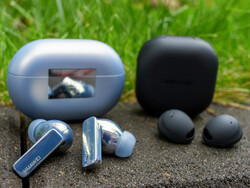
No matter which of the two in-ear headphones you choose, neither is completely free of compromises. The Huawei FreeBuds Pro 2 are clearly ahead in terms of playback quality and telephony. The active noise cancellation is effective in both contenders, and the Galaxy Buds2 Pro are much more enduring in terms of battery runtimes.
If you use the phone a lot and need dual-Bluetooth, the Huawei FreeBuds Pro 2 is the right choice. If you want more battery life and a tighter fit, you should go for the Samsung Galaxy Buds2 Pro.
One point that the Samsung headphones have to accept is that some features only work with Samsung devices. The 24-bit audio codec is especially important, but also the possibility to transfer the Bluetooth connection to another device without pairing it again. For the latter, the FreeBuds Pro 2 is better positioned with full-fledged dual Bluetooth and a clear device manager, especially since there are no restrictions due to different operating systems.
For those who like it even sportier, the Amazfit PowerBuds Pro with an integrated heart rate sensor might be interesting for you. The Jabra Elite 4 Active are both sporty and waterproof and still equipped with aptX.
Price and availability
The Samsung Galaxy Buds2 Pro are available directly from the Samsung online store. They are available cheaper, especially from Amazon.
The Huawei FreeBuds Pro 2 can be purchased directly from the Huawei store. They are also available and somewhat cheaper from Amazon.




